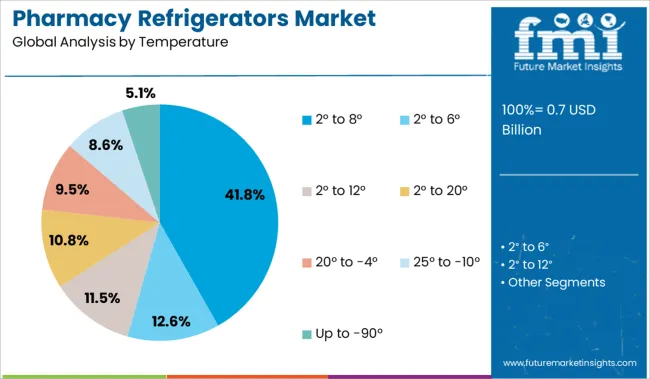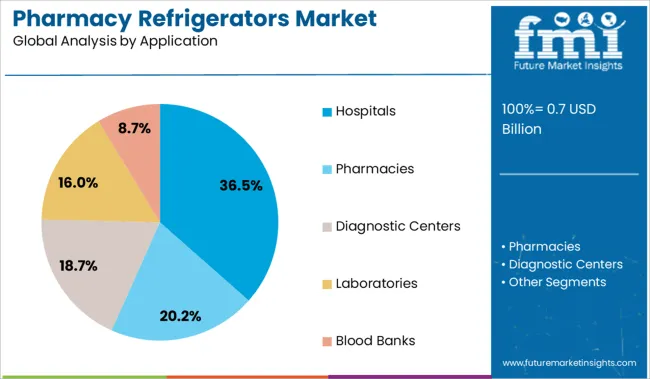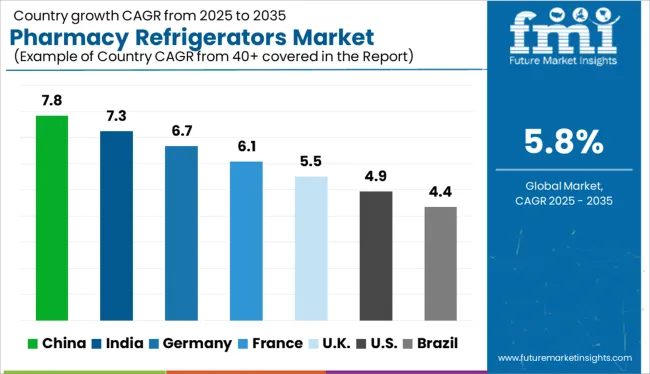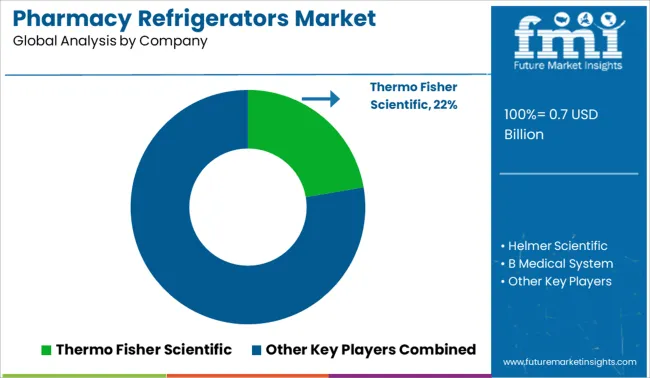The Pharmacy Refrigerators Market is estimated to be valued at USD 0.7 billion in 2025 and is projected to reach USD 1.1 billion by 2035, registering a compound annual growth rate (CAGR) of 5.8% over the forecast period.

| Metric | Value |
|---|---|
| Pharmacy Refrigerators Market Estimated Value in (2025 E) | USD 0.7 billion |
| Pharmacy Refrigerators Market Forecast Value in (2035 F) | USD 1.1 billion |
| Forecast CAGR (2025 to 2035) | 5.8% |
The pharmacy refrigerators market is expanding steadily, supported by the growing need for reliable storage solutions in healthcare facilities to maintain the efficacy of temperature-sensitive medications and vaccines. Industry insights have highlighted the critical role that consistent temperature control plays in preserving the quality and safety of pharmaceutical products.
Increasing healthcare infrastructure development, particularly in hospitals and clinics, has driven demand for specialized refrigeration units designed to meet stringent regulatory requirements. Technological advancements in temperature monitoring and alarm systems have enhanced the reliability of pharmacy refrigerators.
Moreover, rising vaccination programs and cold chain initiatives have necessitated greater deployment of refrigeration solutions capable of maintaining precise temperature ranges. The market outlook remains favorable as healthcare providers continue to prioritize patient safety and pharmaceutical integrity. Segmental growth is expected to be driven by refrigerators maintaining temperatures between 2° to 8° Celsius and hospital applications as the key end-use segment.
The market is segmented by Temperature and Application and region. By Temperature, the market is divided into 2° to 8°, 2° to 6°, 2° to 12°, 2° to 20°, 20° to -4°, 25° to -10°, and Up to -90°. In terms of Application, the market is classified into Hospitals, Pharmacies, Diagnostic Centers, Laboratories, and Blood Banks. Regionally, the market is classified into North America, Latin America, Western Europe, Eastern Europe, Balkan & Baltic Countries, Russia & Belarus, Central Asia, East Asia, South Asia & Pacific, and the Middle East & Africa.

The 2° to 8° temperature segment is projected to hold 41.8% of the pharmacy refrigerators market revenue in 2025, leading all temperature categories. This temperature range is widely recognized as the standard for storing vaccines, biologics, and many pharmaceuticals to prevent degradation.
Healthcare providers have emphasized refrigerators with stable and uniform cooling capabilities within this range to comply with storage guidelines. The segment benefits from technological enhancements such as digital temperature controls and remote monitoring features that improve temperature accuracy and safety.
As immunization efforts expand and regulatory standards tighten, refrigerators maintaining 2° to 8° have become essential in healthcare settings. This segment’s dominance reflects the critical need for precise temperature management to ensure therapeutic efficacy and patient safety.

The Hospitals segment is anticipated to contribute 36.5% of the pharmacy refrigerators market revenue in 2025, retaining its position as the largest application segment. Hospitals require robust refrigeration systems to store a wide range of pharmaceuticals including vaccines, injectable medications, and temperature-sensitive drugs.
The high patient volume and complex medication inventory in hospitals have necessitated reliable refrigeration solutions with continuous temperature monitoring and alarm systems. Hospital investments in expanding and upgrading pharmacy infrastructure have driven demand for advanced refrigeration units that meet healthcare compliance standards.
Additionally, hospitals have increasingly adopted smart refrigeration technologies to support cold chain management and reduce medication wastage. Given the critical role hospitals play in medication storage and distribution, this segment is expected to maintain its market leadership.
The increased prevalence of ailments such as anemia and cancer, as well as the increasing number of surgeries, drive up demand for pharmacy refrigerators. Furthermore, the significance of maintaining optimal temperature and hygiene during the storage and transportation of blood and blood components is anticipated to increase the use of pharmacy refrigerators.
Sales of pharmacy refrigerators are projected to be driven by increased technical and financial aid for the upgrading of healthcare infrastructure offered by government and industry actors. Moreover, pharmacy refrigerators reduce the waste of laboratory chemicals, vaccines, and other biological products caused by insufficient storage conditions. Due to increased government monitoring, the implementation of quality management and GLP procedures drives the pharmacy refrigerators market growth.
Due to the ability to use digital locks that control access to only authorized staff, hospitals, clinics, pharmacies, and diagnostic centers the adoption of pharmacy refrigerators is rising.
The ability to protect temperature excursions caused by power outages, improved airflow, accurate temperature, and monitored alarm systems promote pharmacy refrigerator sales. The development of novel and revolutionary medical refrigerators as a result of Research and Development activity is likely to boost the pharmacy refrigerators' market size.
The global pharmacy refrigerators market share is growing due to robust housing and high-quality components that provide dependability and a long economic lifetime. The ability to reduce the risk of bacterial contamination or volatile substance expansion by maintaining stable temperatures is further propelling the demand for pharmacy refrigerators.
The presence of local players offering affordable alternative products in the market negatively affects the sales of pharmacy refrigerators. Furthermore, the lack of awareness regarding the correct usage of storage refrigerators by upcoming healthcare professionals causing biological products to lose value further impedes the pharmacy refrigerators market growth.
The rising trend of using refurbished equipment across the globe is further anticipated to hamper the demand for pharmacy refrigerators during the forecast period. High cost associated with the integration of medical refrigerators including extensive electricity bills hampers the overall pharmacy refrigerators market size
The rising Research and Development activities to advance the features of reagent storage refrigerators, and government funding to support research activities on the enhancement of medical freezers, are anticipated to boost the pharmacy refrigerators market share.
Considerable improvement and rising success rates in post-transplant outcomes, and promoting organ transplantation are some of the factors propelling the demand for pharmacy refrigerators. Furthermore, the rising number of sports injuries and accidents resulting in the requirement for blood, plasma, and its components is likely to increase the adoption of pharmacy refrigerators.
Several hematological diseases such as hemophilia, blood clots, bleeding disorders, and blood cancers ensuing demand for plasma, promote the pharmacy refrigerators market growth. Moreover, the growing concerns and preparedness for outbreaks of various illnesses and the need for immunization are likely to positively impact the sales of pharmacy refrigerators.

Due to the presence of tight guidelines, particularly in the United States, North America accounts for the highest share of the global pharmacy refrigerators market with a revenue of 35%.
High-quality requirements, as well as significant investment in hospital and healthcare infrastructure, are projected to drive up sales of pharmacy refrigerators in this region.
Reduced pharmaceutical and biological component waste, as well as a high priority to improve patient care, are expected to drive the pharmacy refrigerators market expansion.
Europe is the second most dominating region in the pharmacy refrigerators market share with a revenue of 32%.
The rising geriatric population and increasing prevalence of chronic diseases broaden the global pharmacy refrigerators market size. Furthermore, the lack of low-skilled professionals and technologically advanced systems gaining prominence is anticipated to boost the demand for pharmacy refrigerators.
The Asia Pacific is expected to witness lucrative growth in the pharmacy refrigerators market share. Increasing expenditure on healthcare infrastructure and medical services owing to high economic development in countries such as India, China, and Indonesia is projected to increase the demand for pharmacy refrigerators.
Significant resources invested by governments and private sectors in this region to achieve quality service expand the global pharmacy refrigerators market share.
The rising demand for pharmacy refrigerators is likely to generate significant possible opportunities for startups in pharmacy refrigerators. Furthermore, manufacturers in the market are focused on Research and Development investment and the introduction of improved plasma freezers in order to expand their product line and global reach.
Vestfrost Solutions, Haier Biomedical, PHCbi, Terumo BCT, etc. are start-up companies that are changing the face of the pharmacy refrigerators market by adopting traditional refrigeration systems, as well as improving them with more innovative solutions - such as natural gas refrigerants, offering 40 to 60 percent lower energy consumption.

Key market players are attempting to enhance laboratory pharmaceutical quality control and raise standards, which is fuelling the use of pharmacy refrigerators.
Some of the key participants of the pharmacy refrigerators market are Thermo Fisher Scientific, Helmer Scientific, B Medical System, Philipp Kirsch GmbH, Haier, Accucold, Aegis Scientific, BioMedical Solutions, Inc., Bionics Scientific Technologies (P) Ltd., Coldway and others.
Safety and proper care for blood and plasma surge technological developments in manufacturing medical refrigerators, which key players are bringing to the forefront.
Some of the recent developments in the pharmacy refrigerators market are:
| Report Attribute | Details |
|---|---|
| Growth Rate | CAGR of 5.8% from 2025 to 2035 |
| The base year for estimation | 2024 |
| Historical data | 2020 to 2024 |
| Forecast period | 2025 to 2035 |
| Quantitative units | Revenue in USD million and CAGR from 2025 to 2035 |
| Report Coverage | Revenue forecast, volume forecast, company ranking, competitive landscape, growth factors, and trends, Pricing Analysis, |
| Segments Covered | Temperature, Application, and Region. |
| Regional scope | North America; Western Europe, Eastern Europe, Middle East, Africa, ASEAN, South Asia, Rest of Asia, Australia, and New Zealand |
| Country scope | United States of America, Canada, Mexico, Germany, United Kingdom, France, Italy, Spain, Russia, Belgium, Poland, Czech Republic, China, India, Japan, Australia, Brazi, Argentina, Colombia, Saudi Arabia, UAE, Iran, South Africa |
| Key companies profiled | Thermo Fisher Scientific; Helmer Scientific; B Medical System; Philipp Kirsch GmbH; Haier; Accucold; Aegis Scientific; BioMedical Solutions Inc.; Bionics Scientific Technologies (P) Ltd.; Coldway and others. |
| Customization scope | Free report customization (equivalent to up to 8 analysts' working days) with purchase. Addition or alteration to country, regional & segment scope. |
| Pricing and purchase options | Avail customized purchase options to meet your exact research needs. |
The global pharmacy refrigerators market is estimated to be valued at USD 0.7 billion in 2025.
The market size for the pharmacy refrigerators market is projected to reach USD 1.1 billion by 2035.
The pharmacy refrigerators market is expected to grow at a 5.8% CAGR between 2025 and 2035.
The key product types in pharmacy refrigerators market are 2° to 8°, 2° to 6°, 2° to 12°, 2° to 20°, 20° to -4°, 25° to -10° and up to -90°.
In terms of application, hospitals segment to command 36.5% share in the pharmacy refrigerators market in 2025.






Full Research Suite comprises of:
Market outlook & trends analysis
Interviews & case studies
Strategic recommendations
Vendor profiles & capabilities analysis
5-year forecasts
8 regions and 60+ country-level data splits
Market segment data splits
12 months of continuous data updates
DELIVERED AS:
PDF EXCEL ONLINE
Pharmacy Bags Market Size and Share Forecast Outlook 2025 to 2035
Pharmacy Automation Market Trend Analysis Based on Product, End-Use, and Regions 2025 to 2035
Pharmacy and Drug Store Franchises Market is segmented by Type and Age Group from 2025 to 2035
Market Share Distribution Among Pharmacy Bags Manufacturers
Pharmacy Automation System Market Growth – Demand & Forecast 2024-2034
Pharmacy Accessory Bagging System (PABS) Market
ePharmacy Market Overview – Trends, Demand & Forecast 2025 to 2035
Infusion Pharmacy Management Market
Prescription Pharmacy Bags Market Size and Share Forecast Outlook 2025 to 2035
Industry Share & Competitive Positioning in Prescription Pharmacy Bags Market
Refrigerators Market Trends - Growth & Forecast 2025 to 2035
Prep Refrigerators Market - Commercial Food Storage & Efficiency 2025 to 2035
Reach-In Refrigerators Market – Commercial Cooling & Industry Outlook 2025 to 2035
Household Refrigerators and Freezers Market Analysis - Size, Share, & Forecast Outlook 2025 to 2035
Merchandising Refrigerators Market – Retail Display & Industry Growth 2025 to 2035
Pharmaceutical Refrigerators and Freezers Market
Sandwich Preparation Refrigerators Market

Thank you!
You will receive an email from our Business Development Manager. Please be sure to check your SPAM/JUNK folder too.
Chat With
MaRIA